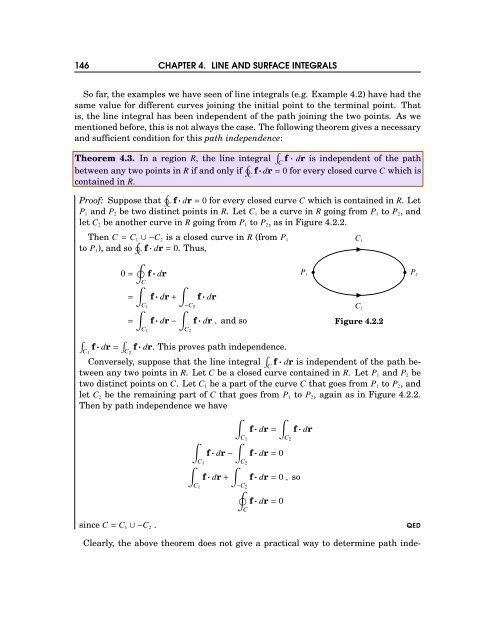Michael Corral: Vector Calculus
Michael Corral: Vector Calculus
Michael Corral: Vector Calculus
You also want an ePaper? Increase the reach of your titles
YUMPU automatically turns print PDFs into web optimized ePapers that Google loves.
146 CHAPTER 4. LINE AND SURFACE INTEGRALS<br />
So far, the examples we have seen of line integrals (e.g. Example 4.2) have had the<br />
same value for different curves joining the initial point to the terminal point. That<br />
is, the line integral has been independent of the path joining the two points. As we<br />
mentionedbefore,thisisnotalwaysthecase. Thefollowingtheoremgivesanecessary<br />
and sufficient condition for this path independence:<br />
Theorem 4.3. In a region R, the line integral ∫ C f·dr is independent of the path<br />
between any two points in R if and only if ∮ C f·dr=0for every closed curveC which is<br />
contained in R.<br />
Proof: Suppose that ∮ C f·dr=0for every closed curveC which is contained in R. Let<br />
P 1 and P 2 be two distinct points in R. Let C 1 be a curve in R going from P 1 to P 2 , and<br />
let C 2 be another curve in R going from P 1 to P 2 , as in Figure 4.2.2.<br />
Then C= C 1 ∪−C 2 is a closed curve in R (from P 1<br />
to P 1 ), and so ∮ C f·dr=0. Thus,<br />
∫<br />
∮<br />
0= f·dr<br />
C<br />
∫ ∫<br />
= f·dr+ f·dr<br />
C 1 −C<br />
∫ ∫ 2<br />
= f·dr− f·dr, and so<br />
C 1 C 2<br />
C 1<br />
◮<br />
P 1 P 2<br />
◮<br />
C 2<br />
Figure 4.2.2<br />
f·dr= ∫ f·dr. This proves path independence.<br />
C 1 C 2<br />
Conversely, suppose that the line integral ∫ C f·dr is independent of the path between<br />
any two points in R. Let C be a closed curve contained in R. Let P 1 and P 2 be<br />
two distinct points on C. Let C 1 be a part of the curve C that goes from P 1 to P 2 , and<br />
let C 2 be the remaining part of C that goes from P 1 to P 2 , again as in Figure 4.2.2.<br />
Then by path independence we have<br />
∫ ∫<br />
f·dr= f·dr<br />
C 1 C<br />
∫ ∫ 2<br />
f·dr− f·dr=0<br />
C 1 C<br />
∫ ∫ 2<br />
f·dr+ f·dr=0, so<br />
C 1 −C<br />
∮ 2<br />
f·dr=0<br />
C<br />
since C= C 1 ∪−C 2 .<br />
QED<br />
Clearly, the above theorem does not give a practical way to determine path inde-








